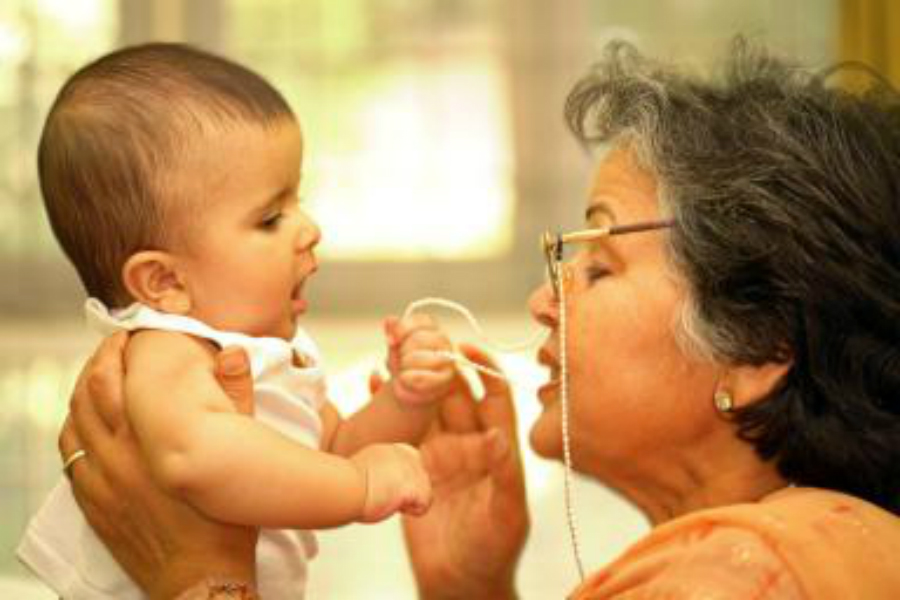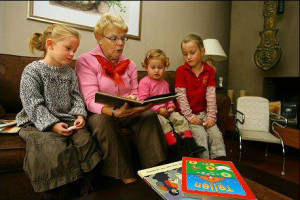Blog
Nurturing the deep roots of intergenerational relationships in everyday life, across the globe

This post, written by Shanti George, emphasizes how important it is to appreciate and nurture existing intergenerational connections, wherever they are able to persist – whether the tradition of bringing infants to visit senior relatives or the support provided by grandparents to young families under pressure — and to build on these and reinforce them with varied and creative initiatives such as those within the Together Old and Young (TOY) programme.
Kerala, India.

My ninety year old mother coos at the infant girl aged four months, who has been placed in her lap by the proud parents who are family connections. The young father records the moment on camera from different angles, smiling each time he moves at the communication in progress between the senior lady and the baby who are separated in age by nine decades. My mother holds out her finger with the shiny wedding ring on it and the baby reaches out to grasp the finger and the ring, then looks up at my mother’s face to see who this is with the interesting finger. ‘You did exactly the same thing when you came to visit me as a baby,’ my mother tells the three year old sister of the infant girl who is observing the scene from behind a nearby chair, clearly not sure whether her precious new sibling should be entrusted so intimately to a white haired stranger. The three year old’s eyes light up and she comes over when my mother beckons to her with the ring finger and invites her to grasp it again, which the little girl does readily. ‘Did I go for the ring too when I was brought as a baby to visit you?’ the mother of the two children asks. ‘You must have, given how you love to go into jewellery shops,’ her husband teases her gently. My mother says that she can’t really remember that occasion from thirty years ago, and turns for possible enlightenment to the grandmother of the two girls who is sitting on a sofa nearby and watching with a soft smile. The grandmother – in her sixties – responds to her daughter with ‘Your first year is a mist of exhaustion in my memory’ and they all laugh. Her son-in-law urges her to join the group around my mother’s chair so that a ‘selfie’ can be taken of four generations.
Den Haag, the Netherlands.

Our street is jokingly described by its residents as a ‘village street,’ even though it is located in the national administrative capital, because people take a keen interest in each other’s lives. It feels like a village this winter evening as I stop with my shopping bag full of groceries to chat with a neighbour who is trimming her hedge. A third neighbour drives up and eases her car into its allotted parking space near where we are chatting. She greets us and says that she is absolutely drained – today was her weekly ‘Grandma’s day’ (Oma Dag) when she babysits her grandchild, and ‘Who would imagine that a one year old who can’t yet walk could nonetheless demand so much energy from an adult!’, she exclaims. ‘Don’t you remember this from when your son was that age?’, I ask and she replies that she expected grandparenthood to be different. ‘I love it though,’ she laughs, ‘Yes, I’m drained but it was fun.’ The other neighbour shuts her garden shears and tells us: ‘Glad the hedge is done. I was putting it off for tomorrow and then I remembered that tomorrow is Grandpa and Grandma’s Day [Opa and Oma Dag] and our four year old grandson would want to help and might get his fingers in the shears. Just as well that there are the two of us to look after two boisterous grandchildren. The eight year old watched me knit last week and got me to start him off on knitting needles for himself, so we’ll continue that tomorrow. His parents said firmly to leave his knitting here and not to take it home.’
These two vignettes — from two very different contexts — illustrate how deeply intergenerational relationships are woven into the social fabric of life in various settings around the world, and how these relationships can persist in contemporary times even though such social fabric has increasingly experienced strains and tensions that weaken it. In India, mobility around the subcontinent and even the world can stretch intergenerational ties, sometimes to breaking point. My mother is fortunate in being able to continue living in her long term home, so that younger generations can follow the very familiar path there. In the Netherlands, children are often cared for after school hours by parents who work part time and are supported by grandparents, but this only works where grandparents live nearby.
Shanti George is an independent researcher who bridges knowledge and practice. She has taught at universities in India, Zimbabwe and the Netherlands, and has also been a programme specialist at the Bernard van Leer Foundation. She is currently an Associate of the Learning for Well-being Community.